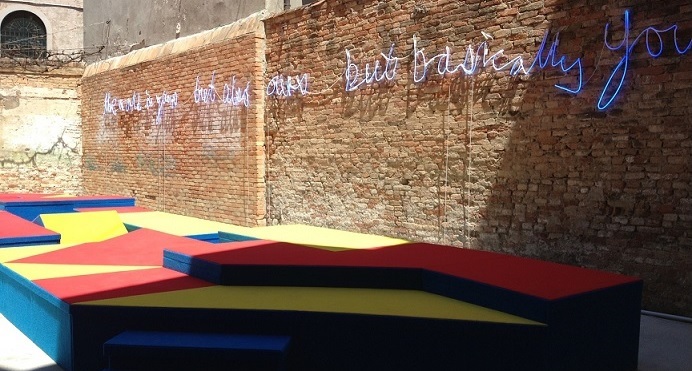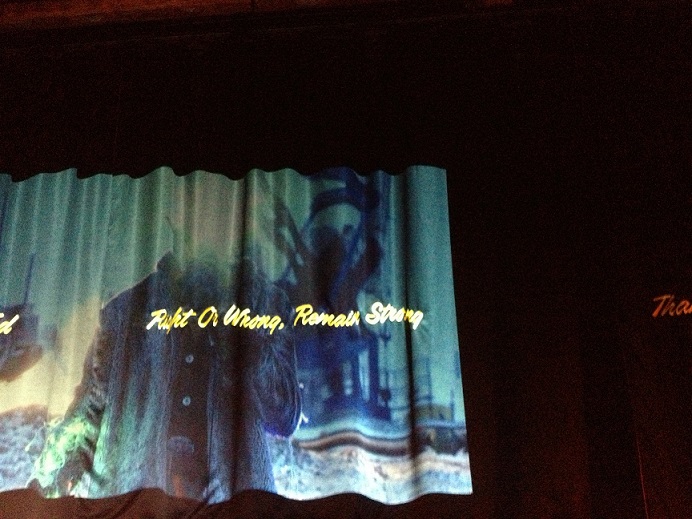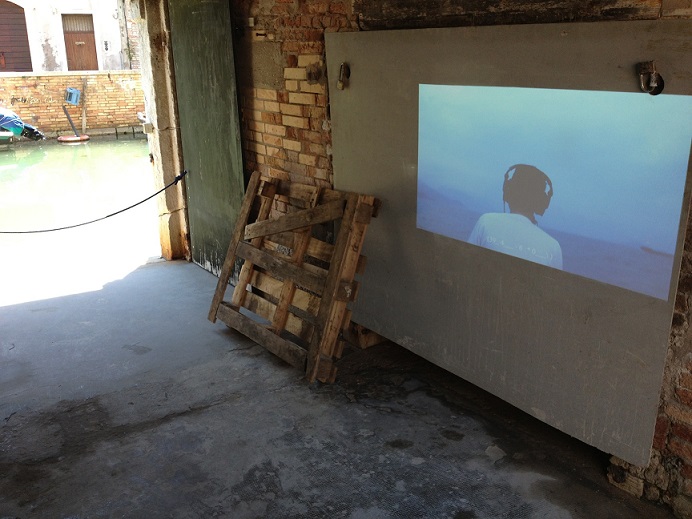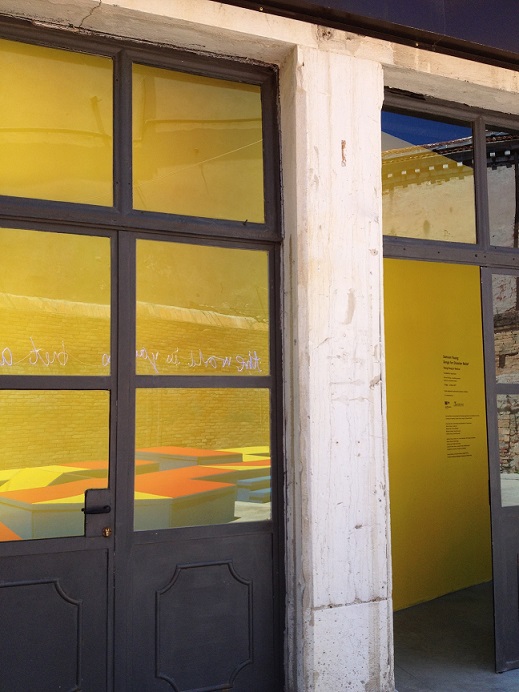Reviews & Articles
Samson Young: SONGS FOR DISASTER RELIEF
Yang YEUNG
at 3:01pm on 21st August 2017





Captions:
1.-5. Installation views of the exhibition in Venice
All Photos by Yang Yeung
(原文以英文發表,評論〈楊嘉輝的賑災專輯〉 - 香港在威尼斯展覽。)
How is honor distributed today? What kind of honor, from and to whom, through what systems, in what structures, and for what reason? Some 2,500 years ago, Aristotle pondered over what makes a life well-lived. The life of honor is one of the candidates. [1] He concludes that while honor is commonly sought, it is not self-sufficient as a good because the giver of the honor may not be honorable itself.
Today, honor is represented as ranking systems with stars, hierarchizing the worthiness of academic institutions all the way to consumer products of the most quotidian kind. Honor is also distributed by the media: it is (still) an honor to be on TV (if for the ‘right’ reason). The systems of distribution produce and perpetuate meanings of value – what is good for the individual and for communities, what is to do good for each other. One of the baselines of Songs for Disaster Relief is the work of honor. It begins from the performative moment of honor constituting the project itself in its precariousness, and moves onto how contemporary popular culture is intertwined with the distribution of honor. Honor becomes a nexus through which a complex and unresolved perplexity is proposed: how a local and global political life is lived today and what might be one that is proper to human beings.
1
In the courtyard, the stage is set. To step onto it is to be inscribed by the pink neon that reads, “The world is yours, but also ours, but basically yours.” Simple words, intricate movements in thinking: at once a statement, a debate, an invitation for negotiation, and an acknowledgement of the futility of negotiation. The empty stage is excessively colorful as if to distract. The words may even be uttered between an imaginary jester’s sinister laughter. It would have taken intellectual honesty and an acute awareness on the part of the artist to offer this radical doubt about his own position in the here-now world stage of contemporary art: a reflection on the terms of distribution of honor.
The trickery begins. I hear music. Like “edged mist” [2], its swing draws me into the rooms. I read the first room as a try-to-be hall of fame, monumentalizing a mangled mess of statues and images of celebrities as memorabilia on the walls. Poised as they are, I walked past them to follow the music to the tele – it seeks our attention; we seek its attention.
The television is set in a living-room-like space, with couches and dim light to get lost in comfort. A video of a singer sensuously dressed in fur plays his performance of glamour. Just about as his singing of “Do they know it’s Christmas time at all?” and “Feed the World” is nearing the uplifting effect, the lyrics give way to the singer humming the sound of the trumpet, which deflects the usual solemnity of the instrument ceremonially employed. Perhaps he is just being playful; perhaps he is signaling dissent to the song he has to sing for some unknown reason, like the stretch of a yawn in response to a boring lecture – it could be natural and involuntary, it could also be a socially acceptable way of conveying the message of switching off. No more hope of singing along – it is not clear how and where else the singer will swing, fling, or toss the song. What’s made familiar by popular culture starts not to deliver.
The tele-glory is accentuated by small medals and prize-like figurines distributed in various spots in the room. Two other teles showing animation videos compete for attention. I read the figure in each of them as a jester, moving sporadically but incessantly, busy but unproductive: he throws as if without a target, dances as if there were no one to watch, somersaults as if he couldn’t stay still. Is showmanship the jester’s goal, or are his decontextualized moves mocking the melancholic luxury in which the singer is staged? In this domestic economy, honor becomes souvenirs. But domestication is incomplete: thick, black curtains transposed from the theatre wrap the room around, slowly turning. Among the many phrases sewn onto the curtain, grief is a prominent message, setting the tone. Without a name, this grief seems to have come from afar, somewhere unknown. Can grief be domesticated? When singing pop songs makes the grief safe, grieving is flattened into an expression of mere goodwill. It may even be argued that it participates in the systematic de-politicization of emotions in larger societies, diminishing our capacity to feel for each other as real human beings. [3]
The domestic economy sets up a context for returning to the try-to-be hall of fame at the entrance. Fragments of facts and fiction conjure up stories of “First World” charity towards “Third World” emergencies. One is led to recall the historical contingency of the idea of ‘development’, an invention after the Second World War, in a particular discourse of the world system, in which one side burdens itself for bringing up the other. [4] The marks on the vinyl records, if read visually, could be understood as an imagery of revolt in the form of vandalism: controlled and patient. If read as sonic appropriation, the marks may be more ambiguous – how deep do they have to be to affect or interrupt the playing of the songs? Are procedures of songs being silenced to an unknown and uneven degree at work?
2
To enter the third room, one needs to pass a coat hanging on the side, which signals an act of waiting, possibly with a tinge of anxiety, sensuously blurring the line between the on-stage and off-stage. On the ground is a doormat that says “wrong side of history”. If one were following how doormats usually welcome those who enter, this mat is deprived of its function for having been turned upside down. But if the doormat were considered to be an object of that marks territories, either room could be the wrong side of history, or, either room could be finger-pointing to the other room that it is the wrong side of history.
The room is set up as a theatre. Sitting there makes us part of the exhibit. A video projection shows a choir of middle-aged aunties and uncles perform “We are the world”. They sing not by giving the song musical tunes, but by rigorously uttering each and every lyric sustained between their collective inhalation and exhalation. Which makes better music - blank verse set not to be sung, or set to be sung to movements other than musical ones? This is a serious question the performance raises. In stark contrast to the swingy singing in the living room, the coarseness of choir’s collective voice gives shape to an explicit critique of the hypocrisy of honor and the dizzying (for being dazzling) effect of pop music on stage. What may make us say the choir is not singing may be more about us than about them – they are not there to sing for and with us, to satisfy our desire to be good. The moment public singing as an established cultural form fails, we become aware of being active participants of interlocking systems that subject real grief to the easy act of singing charity songs.
In his thinking of sound in the discursive production of American consultancies, Holger Schulze argues that the calls for “shifting one’s focus to sound and music is understood as an improvement strategy for Subjects, one which has even be linked to a mystic hope of universal salvation and redemption scenarios.” [5] Schulze points out further that similar claims about the power of music to move our emotional state have also been incorporated into common knowledge about music, which is “precritical” but well-circulated. What is descriptive of how music is perceived is taken to be regulative in education. Schulze calls this “audiopietism”. [6] I find Schulze’s critique solid, shedding light on the specific contingencies of the contextualization of sound in contemporary culture, but I do not think this could be taken as good reason for giving up on the question of how to become a better person. In Songs for Disaster Relief, Young asks a similar question – do we become better persons singing charity songs for disaster relief? But he hasn't stopped at criticism. The project offers a much more nuanced take on how the songs work, through what structures they move – by sustaining them at both proximity and distance from the gravity of disaster, by re-arranging them to suggest the violence they are capable of, the project keeps the question lingering in unease.
Lastly, at the back courtyard that leads to the canal, one singular voice sets itself apart, while also serving to elaborate on the collective voice of the choir. He is singing broken music, Young might say. I find the video installation an extended interpretation of the procedures of silencing (by substitution). The video shows the back headshot of a body wearing headphones, as if to refuse the acrobatics of showmanship and assert his need to be listening by himself. Lyrics in “Like a Bridge over Troubled Water” are substituted by numbers, some continuous, some punctuated, visually represented as broken graphical signs in the subtitling. After all that which shows how musical arrangement is the same condition that gives rise to propaganda and its subversion, what can a trembling voice in troubled waters do but let wind touch the absurd (ir)reality of numbers, for a momentary, precarious relief? The broken numbers addressing fragments of recent histories of violent political oppression attempt to bring moral structure back into the singing, that is, the way a voice moves.
At this point, Songs for Disaster Relief makes itself clearly heard as a patient engagement with politics for two reasons. On one level, the democratic citizen cannot be formed without the presence of others mutually and equally sharing his freedom. On another level, the political subject is cast away, in exile; his alienation from himself comes through the broken singing in a voice not quite his own. In a Facebook chat, Young introduced me to Brian Kane’s understanding of the relation of oneself to one’s voice. Citing Slavoj Žižek and Mladen Dolar, Kane argues that “the voice is not something that I can identify as my own, as something that is properly mine and buried deep within the self. Nor is it exactly the voice of another. […] This voice […] addressing me without being attached to any particular bearer - functions as a stain, whose inert presence interferes like a strange body and prevents me from achieving my self-identity." [7] This counters other philosophical schools that understand the voice as attached to an authentic interiority of the subject – an ‘inner voice’.
I find Young’s artistic gesture of voicing obliquely engaging with these philosophies, while proposing something contextually more complex. On the one hand, he performs with the voice he finds himself in – this voice that is monolingual in Derrida’s sense: “I cannot challenge it except by testifying to its omnipresence in me. It would always have preceded me. It is me. For me, this monolingualism is me. […] It constitutes me.” [8] However, in this video, the voice is not speaking; it is singing. It sings not with and through language, but numbers. The omnipresence of the linguistic voice is somehow evaded, but remains as a capacity to occupy him as constituting him. The lyrics are there and not there – as if a secret exchange is taking place between us, the artist, the listening body in the video, and the original song writer. The numbers may even make language jealous [9] It would therefore be an over-simplification to hear the song sung as a politics of taking sides around cultural nativism. It is not the unified and coherent subject as native that the voice seeks to be; nor is it something foreign.
To use numbers to break up a globally circulated song is a precise choice: numbers define ordinary life; they are seamless, they always work. This is ancient wisdom lived in our times, too: Diophantus of Alexandria says, “You know that all numbers are put together from some multitude of units, it is clear that there is no limit to their production.” [10] To break up the line of numbers is to stop the infinite power of its own production. And one must break it up by itself just as the earworm must be exorcised by its own maker. The voice therefore needs to be alone. Solitude is needed “to have the best intuitions about the real, the true […] It is solitude alone that enables dialogue with everyone else.” [11]
The voice singing in broken numbers is a performative, constituting itself at the duration and in the spatio-temporal relation with other voices in the installation as a whole. It may be feeble and troubled, but it also engages with a politics of subversive hope [12], for acting to both break up and keep singing the song.
3
"But when we sit together, close," said Bernard, 'we melt into each other with phrases. We are edged with mist. We make an unsubstantial territory." [13]
From named disasters to ones that are unidentified, imagined, imminent and immanent, Songs for Disaster Relief shows how the easy singing of charity songs as a cultural form is also situated in an ethics of humanitarian intervention. The movements in living through the emotions associated with disaster and its relief are proposed to be the same structure through which a political life is shaped.
Is politics action, or is it action interrupted or stopped? [14] There is no answer but a clear intention to care for historical and other intertwining realities, to keep the dissenting tunes moving, and to test where the voices are stilled. In this light, Songs for Disaster Relief registers a sensibility of our times – the psychological and material tension between getting carried away by well-oiled systems that work, while being burdened with the gravity of particular kinds of cultural and political violence we make, condone, and are simultaneously subjected to. By rising above the burden of the nation, nationalism, and nativism, it seeks the human capacity for the cosmopolitan spirit [15].
Is Young proposing incompatible visions - between participation and pleasure in pop culture and negotiating what is good for our world, which is, as the stage in the courtyard prescribes, “basically yours”? The potential of negotiation seems precisely to lie in the symbolic language of art - its talent for trickery that enables the necessary distraction from the way honor keeps eating up our attention.
4
I listen to the recording I made of my own walk through the exhibition on June 11, 2017, the first day I arrived at Venice. The mist still hovers. I wonder how an entirely different story could be told as a song would when played backward.
Notes:
[1] By happy (Greek Eudaimonia), Aristotle means a life that flourishes; happiness isn’t temporary pleasure, let alone extreme hedonism. To seek honor for a flourishing life is common, but for Aristotle, not compelling. “The cultivated people, those active [in politics], conceive the good as honor, since this is more or less the end [normally pursued] in the political life. This, however, appears to be too superficial to be what we are seeking; for it seems to depend more on those who honor than on the one honored, whereas we intuitively believe that the good is something of our own and hard to take from us.” (Nicomachean Ethics, tr. Irwin, 1095b20-25)
[2] Virginia Woolf, The Waves, Oxford University Press. 1931/1998: 10.
[3] See Martha C. Nussbaum’s Political Emotions: Why Love Matters for Justice (2013) for an argument on the importance of the “political cultivation of emotions” for justice.
[4] From Arturo Escobar’s Encountering Development, the making and unmaking of the Third World. Princeton University Press. 1995.
[5] See Sound as Popular Culture: A Research Companion, eds. Jens Gerrit Papenburg and Holger Schulz, MIT Press. 2016: 4.
[6] ibid.
[7] Brian Kane, Sound Unseen: Acousmatic Sound in Theory and Practice, Oxford University Press. 2014.
[8] See Jacques Derrida, Monolingualism of the Other; or, The Prosthesis of Origin, tr. Patrick Mensah, Stanford University Press. 1998:1.
[9] I am inspired by the source Derrida cites in Monolingualism of the Other; or, The Prosthesis of Origin – Abdelkebir Khatibi’s Amour bilingue, which says that the birth to language is a story that language itself was jealous.
[10] From Arithmetica of Diophantus of Alexandria, Book I. (circa 3rd century CE); also much earlier, from Euclid’s Elements, Book VII (circa 300 BCE), “A number is a multitude composed of units.” A number is therefore always of something.
[11] “The Art of Living: A conversation with Michel Serres” in Mary Zournazi’s Hope: New Philosophies for change, 2002: 206.
[12] In “When Hope is Subversive”, Henry A. Giroux says, “Hope is more than a politics, it is also a pedagogical and performative practice that provides the foundation for enabling human beings to learn about their potential as moral and civic agents. Hope is the outcome of those educational practices and struggles […]. Educated hope is a subversive force when it pluralizes politics by opening up a space for dissent, making authority accountable, and becoming an activating presence in promoting social transformation.” (Tikkun, Vol. 19, No. 6. 2004:39)
[13] Virginia Woolf, The Waves, Oxford University Press. 1931/1998: 10.
[14] Shannon Jackson registers the contingency of perception in the evaluation of art works – for instance, the perceptual shift that distinguishes theater from, say, visual art. In the theatre’s “commitment to temporal movement”, she argues, it is when action stops that political engagement occurs, while it is the reverse in the commitment to the object in visual art. By extension, one might argue that as with theatre, music requires termination of action to become political. The question may then become how that termination is exercised. See Social Works: Performing art, Supporting publics. Routledge. 2011:3-4.
[15] In “Perpetual Peace: A Philosophical Sketch” (1795), Immanuel Kant proposes, “’Hospitality’ here indicates the Right of a stranger in consequence of his arrival on the soil of another country, not to be treated by its citizens as an enemy. […] All men are entitled to present themselves thus to society in virtue of their Right to be common possession of the surface of the earth, to no part of which anyone had originally more right than another; and upon which, from its being a globe, they cannot scatter themselves to infinite distances, but must at last bear to live side by side with each other. […] These may at last become publicly regulated by law, and thus the human race may be always brought nearer to a Cosmopolitical Constitution.” (See particularly Part III “Third Definitive Article in the conditions of a Perpetual Peace. ‘The Rights of men as Citizens of the world in a cosmo-political systems, shall be restricted to conditions of universal Hospitality.’” (https://slought.org/media/files/perpetual_peace.pdf.) I speak of Songs for Disaster Relief concerning itself with the cosmopolitan spirit in this older sense because of the way singing as a popular cultural form is taken to belong to no particular locality, where contentions about who we are and for whom meet and resolutions could be negotiated. I see in the project a concern to be hospitable to that which may not be up to us, arriving at our door.
This article was first published in CoBo Social, August 2017, www.cobosocial.com.
